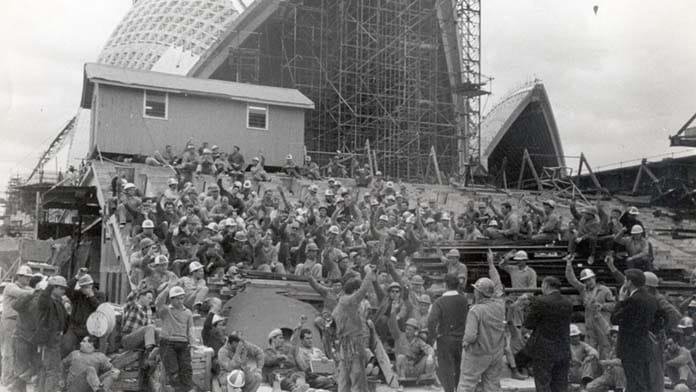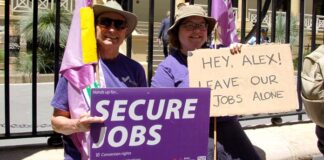Tom Orsag looks at how the NSW BLF set the standard for militant construction unionism as a result of years of rank-and-file organising in the union
The NSW Builders Labourers Federation (BLF) of the 1970s was famous for its militancy. It raised the pay and status of builders’ labourers with two mass strikes in 1970 and 1971 and then implemented the famous “Green Bans” to save the environment.
The BLF’s proud tradition of militant left-wing unionism was later incorporated into the CFMEU construction union.
But the BLF wasn’t always a fighting left-wing union. For decades the NSW branch of the union was controlled by some of the worst officials imaginable.
It took ten years of patient rank-and-file organising to build the militant, socially aware union of the late 1960s.
The current attack on the CFMEU is aimed at wiping out this kind of unionism. Most of the militant leadership of the union has been sacked and replaced with administrators.
The officials and organisers who remain are now increasingly restricted, threatened with sacking if they disobey the directions of the unelected administrators.
This puts more responsibility on rank-and-file delegates and activists to hold the union together and stand up to the government-appointed administrators as they attempt to weed out militancy.
The way rank-and-file activists in the BLF built the traditions of militancy and won control of the union contain valuable lessons for building rank-and-file organisation to defend the CFMEU from the corrupt administration today.
The story is brilliantly told by Paul True in his pamphlet Rolling the Right.
Brawl
Fred Thomas gained control of the NSW BLF in 1941, after the old officials were removed by the union’s federal office in Melbourne.
Thomas ran the union like a gangster, sending thugs to beat up opponents inside the union and paying them to stack union meetings. If there was opposition to him at a meeting it usually descended into a brawl.
Later, it was discovered that he had stolen or misused around $300,000 of union money over the years.
Thomas did his best to avoid strikes or any effort to improve conditions. Migrant workers in the industry were openly mocked in racist terms in the pages of the union journal.
Conditions in the industry were rough, with almost all the lifting and digging done by hand. Workers were divided between different unions—in particular the BLF for the labourers and the Building Workers Industrial Union (BWIU) for the carpenters and bricklayers.
The BWIU at the time had a Communist leadership and was more willing to fight for its members. Thomas instructed BLF members never to cooperate with them, making united action on sites impossible.
Neither the builders nor the government cared that Thomas was a corrupt gangster because he ran a union that never threatened builders’ profits.
His neglect of pay and conditions meant that, by the early 1960s, builders’ labourers in NSW were paid 15 per cent less than in Victoria.
In 1955 anger at the failure to get a wage increase forced the union to lead a strike.
Thomas called it off after four days following an unwritten “gentlemen’s agreement” with the Master Builders Association. This allowed the bosses to later renege on it.
Hoist
A Rank and File Committee (R&FC) was finally formed in 1951 by a handful of Communist Party (CPA) members within the union.
It built up support through years of rank-and-file organising, leading strikes on individual sites and producing a newsletter called Hoist that was distributed on job sites every few months.
The newsletter agitated around workplace issues like the lack of “wet weather” pay and basic amenities such as drinking water, toilets or lunch sheds on sites.
Their first public meeting saw just five Communist Party members and ten other rank-and-file union members attend.
The group led its first strike at the Goodyear site at Camellia, demanding pay for days of work cancelled due to wet weather. The strike united tradesmen and BLs and they won two hours’ pay rather than the previous “fares” to get to the job if it was “rained off”.
This strike built the reputation of the R&FC. They worked to win the support of union delegates at different sites, organising on big projects including the St Mary’s munitions factory with 4000 workers.
As one activist told Paul True, “We really became established in 1956 when the big job started in St Mary’s.
“There was a thousand builders’ labourers on it. There would have been about 20 builders’ labourers delegates on the job, we had about 15 of them supporting the Rank and File. Blokes that had problems, they could always come to the Rank and File Committee and raise their problems there.”
Thomas held onto control of the union through gangster-like violence.
At union branch meetings, members of the R&FC could speak only if they organised four or five others to sit surrounding them and hold off Thomas’ thugs as they rose to speak.
Things got worse as the challenge to the union leadership grew. One activist, Don McHugh, recalled that Thomas began bringing heavies to union meetings who “used to open up their coats and show you the butt of their revolvers”.
Boom
In early 1957, Thomas gave up, taking a six-month leave of absence and never returning to the union. The R&FC backed a former Thomas ally, “Banjo” Patterson, in an election against another right-winger.
Patterson was elected the new secretary and the R&FC and the broader left won four lower-level positions within the union.
Boom conditions had produced a widespread wave of strikes across other industries and building workers were also becoming more militant.
Patterson went along with this new mood and the R&FC worked with him. They were prepared to cooperate with officials and other groupings within the union when they showed they were serious about fighting for workers’ rights.
Under the new leadership, the union worked together with members of the BWIU and other construction unions for the first time to organise joint campaigns.
A combined building unions mass meeting was held at Sydney Stadium over pay rises and safety, something unheard of previously.
But it wasn’t to last. The right rigged the union election in November 1958 and an old official from the Thomas-era, Bill Bodkin, became secretary for the next three years.
It was a demoralising outcome but the R&FC continued to organise on the job.
In a sense they had to. As True wrote, “The most striking feature of the new leadership was their utter laziness. Increasingly … jobs were being left to their own devices.”
As Jack Mundey explained, it was “a blessing in disguise” because it allowed the rank-and-file group to establish control of the delegates networks on building sites.
Considerable
At the time the union still held regular members’ meetings that had considerable power, including the ability to elect paid organisers where there was a vacancy.
The rank-and-file group was now able to organise enough members to the meetings to win elections.
The Bodkin leadership’s response was to turn meetings into a farce, using control of the chair to declare motions carried when they were clearly defeated. When challenged they simply walked out and shut down the meeting.
Out of frustration, the rank-and-filers adopted a new tactic at a union branch meeting in January 1961, attended by 200 members.
Shortly after 8pm, Bodkin attempted to shut the meeting down and leave, knowing he was outnumbered. So as Mundey explained, “Bodkin kept descending the stairs and I kept picking him up, carrying him back and sitting him in his seat.” With Bodkin still present the meeting could then continue.
“It was the first democratic meeting ever held in the Builders Labourers … we kept them sitting in their seats till 10 o’clock.”
The R&FC followed up the next day by holding a stopwork rally, marching 1000 building workers to Trades Hall.
Decisively
By the time of the 1961 union election, the right-wing group running the union had split.
The Left decisively won the November 1961 union election on a joint ticket of the R&FC and left-wing ALP members. They won 17 of the 21 positions up for election.
The Left assumed control of a union drowning in debt, with little experience of running a union and a newly-elected secretary, left-wing Labor Party member Mick McNamara, who was only 22.
Within a short period, the new leaders were able to increase participation in the monthly branch meetings and launch a number of militant actions.
Despite a formidable challenge from the Right at the following election in 1964, the Left and R&FC won even more decisively.
In 1968, with McNamara resigning due to ill health, CPA member Jack Mundey was elected secretary with Labor member Bob Pringle as president. Along with CPA member Joe Owens, elected as organiser and later as assistant secretary, they formed the core leadership of the reformed branch.
This saw the NSW BLF became a model of radical and militant unionism.
Its achievements in civilising the building industry, improving wages and conditions, as well as championing social causes including the Green Bans and Aboriginal rights are another story.
But this was made possible not simply through replacing a group of right-wing union leaders with left-wing officials.
The Left leadership of the BLF built its support through organising on the job over many years among union delegates and activists.
The real source of union dynamism and power is rank-and-file organisation and strength on the job—able to work with the officials when they fight for workers’ interests, but independently of them when they don’t.
That’s the real lesson of the BLF Rank and File Committee—and the struggles that followed in what became Australia’s best trade union to date.
Read Paul True’s Tales of the BLF: Rolling the right online at https://bit.ly/BLF-history






